Beginner’s Japanese – Chapter VI – Keigo
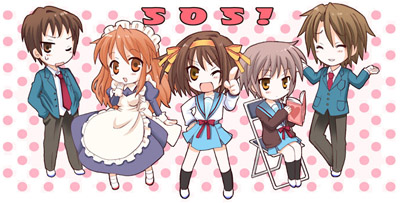
You hear it in anime and drama all the time, often without realizing it. It is the bane non-native Japanese speakers (or at least one of the numerous). It lurks in the shadows as it descends upon you with such suddenness and ferocity that leaves you confused and speechless. It was invented by the Japanese with the sole purpose of making foreigners suffer in eternal damnation and to punish us for pretending to speak the language.
It is 敬語 (keigo), or the dreadful “levels of politeness” in Japanese. Haruhi save us all. Keigo mainly involves the manipulation of verbs. Please read the chapter on verbs first if you haven’t already.
Japanese is a very polite language. You can barely swear with it. In fact, the easiest way to be insulting in Japanese is simply to NOT be polite. In that respect, Japanese is whole new world for English speakers.
There are various grammar rules dealing with politeness and they are all categorized under 敬語 (keigo). 敬 means “respect” and 語 means “language/words”, so it literally means “words of respect”. Clever, huh?
The types of Keigo are mainly as follows:
- 尊敬語 (sonkeigo) – Honorific form
Used to show respect for the actions/possessions of people who are higher in social status than you. (i.e. teachers, elders) - 謙譲語 (kenjougo) – Humble form
Used to belittle the actions/possessions of yourself or people in your “group” so as to be humble. - 丁寧語 (teineigo) – Polite form
Used for general politeness required when dealing with strangers/unfamiliar acquaintances. - 丁重語 (teichougo) – More Polite form (?)
Not sure about the English term; more polite than teineigo and has generally been subsumed under kenjougo. - 美化語 (bikago) – Beautification form (?)
Not sure about the English term; this simply refers to the addition of お (o-) or ご (go-) in front of nouns to make them more… uh… dignified? This has generally been subsumed under sonkeigo and teineigo.
A lot of textbooks teach the last two categories as part of the first three, so generally you will only learn three types of Keigo: honorific form, humble form and polite form.
尊敬語 (Honorific form)
ZOMG sir you are totally cool and awesome! Your brilliantness makes me tremble in orgasmic reverence and please confer upon me the honour of having your children! Heartfelt appreciations from the bottom of my heart!
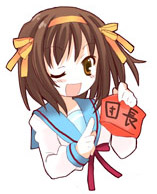
Okay, so maybe it’s not that extreme, but the general idea of the honorific form is to glorify every action and item associated with a person who is of a higher social rank than you. This social rank can come in many forms, such as age, experience, wealth, skills and family structure.
Whether you use sonkeigo or not does not depend on who you are speaking to. Rather, it depends on who you are speaking about (of course the listener is often that person, but not always). This is very important.
Some situations where you have to use honorific form to describe the actions of another person:
- You are describing the actions of your superior
- You are speaking about the founder of your school
- You are speaking about a teacher whom you respect
- You are speaking about a well-respected historical figure
- You are trying to suck up to that person
- You are referring to a national leader
- You are referring to Haruhi-sama
- You are a maid speaking about your master
Here’s an example:
kana: キョンは閉鎖空間に入った。
ro-maji: kyon wa heisa kuukan ni haitta.
english: Kyon entered the Sealed Dimension.
kana: ハルヒ様は閉鎖空間にお入りになった。
ro-maji: haruhi-sama wa heisa kuukan ni ohairi ni natta.
english: Haruhi-sama entered the Sealed Dimension.
The two sentences above share the same meaning, but 入る (“to enter”) is replace with お入りになる for Haruhi-sama because we are describing the actions of a higher being. :P This is the basics of honorific form.
A more complex example:
kana: これは私の弁当だ。
ro-maji: kore wa watashi no bentou da.
english: This is my bentou.
kana: そちらのはハルヒ様のお弁当でいらっしゃる。
ro-maji: sochira nowa haruhi-sama no obentou deirassharu.
english: That is Haruhi-sama’s obentou.
Note the numerous changes made to the sentence even though the meaning stays the same. Keigo is like a whole new language by itself.
The prefixes お or ご (depends on the word) for nouns make them more polite. This is usually used in conjunction with the honorific form, but there are some words that almost always come with the prefix. For example, お金 (okane) and ご飯 (gohan). There are also some nouns that convert differently, for example the bikago of 家 (ie), which means “house/home”, is usually お宅 (otaku) and not お家 (oie). BTW, that is where “otaku” came from, but that’s a topic for another day…
Some common conversions to honorific form for verbs:
To go: 行く (iku) → いらっしゃる (irassharu)
To come: 来る kuru) → おいでになる (oide ni naru)
To be: だ (da) / である (dearu) → でいらっしゃる (deirassharu)
To eat: 食べる (taberu) → 召し上がる (meshiagaru)
To look: 見る (miru) → ご覧になる (goran ni naru)
To know: 知る (shiru) → ご存知である (gozonji dearu)
To say: 言う (iu) → おっしゃる (ossharu)
Still with me? Good. Fortunately, most conversions to honorific form are not as senseless. The examples above are actually the exceptions. Most verbs follow a general rule when converting to honorific form:
お + Root -masu form + になる
Simple huh. Some examples:
To listen: 聞く (kiku) → お聞きになる (okiki ni naru)
To enter: 入る (hairu) → お入りになる (ohairi ni naru)
To meet: 会う (au) → お会いになる (oai ni naru)
Please read my chapter on verbs if you don’t know what is -masu form.
There are of course other rules associated with honorific form, such as the passive honorific. But you get the general idea… right?
謙譲語 (Humble form)
I suck. I am the most useless person in this room. All my so-called achievements could never have happened in a million years without the help of everyone here. I will go orz in that corner now.
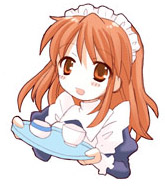
For some reason, Mikuru comes to mind. But nevermind, it’s not important.
Anyway, kenjougo or the humble form is used to describe your own actions and the actions of people who are in your “in-group”. It is used when speaking to a person of higher level or equipped with more +rep rare items.
An “in-group” is a vague and Japanese definition that changes depending on the situation, but the general idea is people who are close to you and are on the same level as you, such as your classmates and your siblings.
Some situations where you have to use humble form to describe your own actions:
- You are speaking to your company’s CEO
- You are a student speaking to the headmaster
- You work in the service industry
- You are speaking to your ancestors through a spirit medium
- You are a maid
slavingworking for Haruhi-sama - You belong to a harem and your character type is submissive
- You are just really polite all the time (until you go oyashiro)
- Your first name is Kotonoha
Example:
kana: キョン:「俺はSOS団に入った。」
ro-maji: kyon: “ore wa SOS-dan ni haitta.”
english: Kyon: “I joined the SOS-dan.:
kana: みくる:「私はSOS団にお入りしました。」
ro-maji: mikuru: “watashi wa SOS-dan ni ohairishimashita.”
english: Mikuru: “I joined the SOS-dan.”
That’s basic kenjougo. You can be even humbler:
kana: 私はSOS団にお入りさせて頂きました。
ro-maji: watashi wa SOS-dan ni ohairisasete itadakimashita.
english: I joined the SOS-dan.
It still means the same thing, but now the sentence translates literally to “I gratefully received the permission to join the SOS-dan.”
If you’ve ever watched Ai Yori Aoshi, let me just tell you that Aoi spent the entire series speaking this way. Go rewatch it if you don’t believe me. She uses keigo no matter who she’s speaking to. It’s scary.
Some common conversions to humble form for verbs:
To go: 行く (iku) → 伺う (ukagau)
To come: 来る kuru) → 参る (mairu)
To be: だ (da) / である (dearu) → でござる (degozaru)
To eat: 食べる (taberu) → 頂く (itadaku)
To receive: もらう (morau) → 頂く (itadaku)
To look: 見る (miru) → 拝見する (haikensuru)
To know: 知る (shiru) → 存じる (zonjiru)
To say: 言う (iu) → 申す (mousu)
So now you know where “itadakimasu” came from. :P Just like with honorific form, the above examples are actually exceptions. Most other verbs follow a general rule when converting to humble form:
お + Root -masu form + する
Please note that the end is suru and not naru like in honorific form (if you use honorific form on yourself, you’re gonna get it). Some examples:
To listen: 聞く (kiku) → お聞きする (okikisuru)
To enter: 入る (hairu) → お入りする (ohairisuru)
To meet: 会う (au) → お会いする (oaisuru)
I shall not go into the passive humble form since I have yet to even cover regular passive form… Oh well, maybe another day. :P
丁寧語 (Polite form)
Look at me! I speak like a little girl!
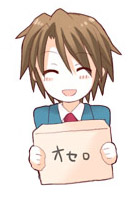
Ok this is not so true. But the fact is that using the polite form when you are not supposed to makes you sound like a little girl.
The polite form is easier to understand than honorific and humble forms. You use it to be polite to the person you are speaking to, that’s about it. Social status doesn’t really matter here. You can use honorific and humble forms whether or not you are using polite form.
Polite form makes you sound more formal. You generally use it when speaking to strangers or people who are not emotionally close to you. If you are a girl, you can use it all the time and not sound weird. But I think younger people generally prefer to speak in normal form when they are among peers.
Polite form is basically -masu form. That’s about all there is to it. I covered it in my chapter on verbs under the heading “Part II: “-masu” Form“.
But just to illustrate the difference again, here are some examples:
食べる (taberu) → 食べます (tabemasu)
行く (iku) → 行きます (ikimasu)
来る (kimasu) → 来ます (kimasu)
The same also apply to their honorific forms:
召し上がる (meshiagaru) → 召し上がります (meshiagarimasu)
いらっしゃる (irassharu) → いらっしゃいます (irasshaimasu)
おいでになる (oide ni naru) → おいでになります (oide ni narimasu)
And their humble form:
頂く (itadaku) → 頂きます (itadakimasu)
伺う (ukagau) → 伺います (ukagaimasu
参る (mairu) → 参ります (mairimasu)
As you can see, polite form is really independent of humble form and honorific form. And much simpler too.
When to use Keigo

So how do you know when you should use which type of keigo? Well first you have to know who you are speaking to. If the person is a stranger or if you are unfamiliar with him/her, use polite form. If the person is higher level than you, use honorific form when describing his/her actions or when making a direct request and use humble form for yourself and your peers.
For example, if you are a waiter/waitress speaking with your customer, you speak in polite form and use honorific form to refer to his/her actions. You use humble form to refer to your own actions, the actions of your co-workers and the restaurant you represent.
Even when speaking with your friends, it is sometimes necessary to use honorific and humble forms because it also depends on the topic of the conversation. If you are telling your friends about a present which you received from your boss, then it is necessary to use honorific form for the parts that are describing your boss’ actions, even though you are not speaking in polite form with your friends.
Conclusion

Knowing how to correctly apply keigo is one of the most important things that determine your fluency in Japanese. Although it is getting less and less popular among Japanese teenagers to use keigo, it is still an important part of Japanese and will continue to be.
Also, keigo sounds pretty darn cool if you can spew it out fast enough like they do in anime. :P Really, I don’t know what is wrong with Japanese kids these days…
In this chapter, we talked about:
- Types of keigo
- Honorific form
- Humble form
- Polite form
Have fun~
I still haven’t decided on the topic for the next chapter. Maybe more on verbs or maybe something else.
P.S. I did promise that this chapter would be Lacus-sama… but I realized that I have very few usable pictures of her! Now if anyone could send me their collection that would be great… XD
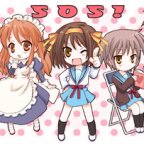






September 24th, 2006 at 8:23 pm
Er, I’ve never heard ます forms of verbs included in 丁寧語 before. I’ve always heard 丁寧語 included things like ございます which is the polite form of あります (i.e. the verb for inanimate existence) but doesn’t refer to the honor or humility of anyone (cuz, y’know, it’s inanimate and all).
いらっしゃる can also be used as 尊敬語 for 来る instead of just おいでになる/お出でになる. (Yes, いらっしゃる is the 尊敬語 for all three of 行く, 来る, and いる.) And actually, 参る is the 謙譲語 for 行く as well as 来る. 伺う is the 謙譲語 for 聞く.
Also, technically でございます is 丁寧語 not 謙譲語 even though it’s often used as 謙譲語 since there’s no 謙譲語 form of the copula. I ramble on a bit about this topic in some comments on lj, though it’s more about the copula and verbs for existence than it is about 敬語 per se.
September 24th, 2006 at 9:00 pm
丁寧語 refers specifically to -masu form. Gozaimasu is sometimes used in 丁寧語 but not always. It used to be the teinei suffix for adjectives but now we usually use desu. Refer to this page.
I don’t think でございます is 丁寧語, since ございます in 丁寧語 deals only with adjectives. Maybe you are confusing it with 丁重語, which from what I understand is usually treated as 謙譲語 now. Refer to the Japanese wikipedia entry on keigo for more on teichougo.
September 25th, 2006 at 12:17 am
Say, Chapter V is broken, just so you know.
September 25th, 2006 at 2:01 am
Keigo is by no means completely intuitive, but I’ll take it over noun gender or irregular spelling any day.
Thank you. You’ve once again proven that Japanese is NOT the impenetrable lingual fortress most make it out to be.
September 26th, 2006 at 9:39 am
ござる is used outside of the stock phrases listed on the site you linked to. That is, it is indeed still used as a verb and not just as an adjectival suffix. As a verb is is a polite (suppletive) form of ある and so can be used in all the places where ある is used as a standalone verb. I’m uncertain whether ござる can replace ある in constructions such as 〜てある and the like since I’ve not seen it done myself.
It may indeed be 丁重語 instead of 丁寧語, I’m not sure as apparently my idea of 丁寧語 is off. But it is 敬語 and neither 尊敬語 nor 謙譲語. And there is certainly a difference between 「あります」 and 「ございます」; the latter is polite whereas the former is merely “formal”, for lack of a better term. Whatever the terminology may be, でござる is in the same class as ござる itself.
September 26th, 2006 at 4:53 pm
ござる can indeed replace ある in most constructions to be more formal. But my point was that such usage is part of 丁重語 and not 丁寧語. In 丁寧語, ございます is for adjectives only and this usage is seldom seen anymore other than in stock phrases like お早うございます since we normally just use です for adjectives in 丁寧語 now.
I did mention at the beginning that 丁重語 is not strictly speaking 謙譲語 – since they work differently (one concerns itself with being polite to the listener while the other is based on the sentence topic). However, a lot of modern textbooks classify it as such so as to group all 敬語 into the three major categories.
September 27th, 2006 at 1:38 am
「私はSOS団にお入りしました。」
Watashi wa SOS dan ni ohairi simasita.
「私はSOS団にお入りさせて頂きました。」
Watashi wa SOS dan ni ohairi sasete itadakimasita.
=>
「SOS団に入らせて頂きました。」
SOS dan ni hairasete itadakimasita.
I think that first two sentences are strainge.
So I transform it to third one which is right japanese 謙譲語.
Basically, when you use kenjo-go, you mention your own thing.
So you do not have to use 「私は」(“I”).
Another example:
「このたび、SOS団に入団させて頂きました、
朝日奈みくると申します。
よろしくお願いします」
Konotabi, SOS dan ni nyuudan sasete itadakimasita,
asahina mikuru to mousimasu.
yoroshiku onegai simasu.
—
The example of sonkeigo is also strainge.
But an explanation is too bother for me.
そちらのはハルヒ様のお弁当でいらっしゃる。
=>
そちらはハルヒ様のお弁当でございます。
September 27th, 2006 at 5:58 pm
“The example of sonkeigo is also strainge.”
Actually, it’s spelt “strange”. [/non japanese related comment] XD
September 27th, 2006 at 10:57 pm
A man, who point out strange japanese, used strange engrish. :P
So you should call me baka nihon-jin.
October 25th, 2006 at 7:29 am
Hi i’m Armando from peru. My natal language is the spanish but i know a little of english… u know :P well i’m here ’cause i wanna learn a little of the magnifical as japanesse language jeje i like a anime called Onegai Teacher i love it ! it is the reason ‘bcause i wanna know :P ehehe … Thx 4 the help :D
pdt: if u know about the japanese anime (O.T.) write me … could u be my friend :D…
Bye.
Ow about the examples… i don’t know what to say :P eheheh.
November 7th, 2006 at 6:46 pm
In sonkeigo & kenjougo, how would we know where to ‘O’ and ‘GO’ with noun, adjective and verbs? For example, gokazoku, oisogashii, goannaisuru etc.
November 7th, 2006 at 11:47 pm
lol, isn’t there also some habbit of adding “O” before everyone’s name? Particularly for the ladies?
November 8th, 2006 at 3:35 pm
Speaking very generally, “o” is used for words native to Japanese while “go” is used for words that came from Chinese.
December 8th, 2006 at 6:22 pm
“Where is your o-Haruhi-sama now?”
OIC, Haruhi is a Japanese.
So If I want to send a letter to the senior minister of Singapore,
“To go-Goh Chok Tong-様” That`s right, go go GO!
August 2nd, 2007 at 8:51 am
Wow, I just read them all. Good job ^^.
USUALLY “O” goes before words formed by one kanji, and “GO” before two kanji ones.
Examples:
お金 | okane | money
お皿 | osara | plate
ご家族 | gokazoku | family
ご挨拶 | goaisatsu | greetings
An exeption:
お名前 | onamae | name
It’s generally like DarkMirage said.
I never heared about putting “O” before a name… but it can be a modern habbit, as you said.
August 20th, 2007 at 12:45 pm
I’m planning to go on a trip to Japan, this will definately help in my study! Danke schon!
October 23rd, 2007 at 3:36 am
Looks like its been a year since this section was updated, but if u r looking for a topic, sound words might be interesting. Sorry i forgot the actual term, but youll get wat i mean from this page. http://www.thejapanesepage.com/ono.htm
These things r so convenient and expressive that i often mistakenly mix them into my singlish.
A chapter on the ending of sentences might also be interesting. eg
http://japanese.about.com/library/weekly/aa110401a.htm
Besides the conventional, theres also stuff like how dejiko ends her sentences in “nyo” etc. absolutely no meaning, but cute. in this respect Japanese is very expressive.
January 25th, 2008 at 11:37 am
I have a question. what does aru mean? I saw it in Hare Hare Yukai.
Lyrics:
Aru Hare tohi no koto
Mahou ijou no yukai wa… and so on. What does aru mean?
February 3rd, 2008 at 12:18 am
This kind of “aru” means something along the lines of “one”, “some”, “a certain”, etc. For example, “aru hi” is “one day”, not quite as in “one, instead of two or three”, but more like “there’s this one day”. I’ve seen “aru hi” used to begin reciting a tale; it kind of strikes me as a stock similar in use to “once upon a time” but I could be off on this one.
April 14th, 2008 at 4:44 pm
i’m learning about keigo now for my ronbun.looking for any article of keigo.
April 14th, 2008 at 4:53 pm
please tell me about any change in this latest of keigo,it will help so much for my study.
Trackback from
Ishi No Ue - Japanese Language Learning » 敬語June 29th, 2008 at 12:25 pm
[...] That’s all there is to it. For all the ins and outs of Keigo, then try this page or this one. [...]
October 7th, 2008 at 11:07 pm
ある晴れた日のこと~
魔法以上のユカイが~
desune.
nihonzintoshitemo
konna saitoga arukotozitai
sirimasenndeshita.
watashinitottemo keigo ha muzukasiito
omoimasu.
December 17th, 2008 at 3:38 pm
Thank you for this! It’s a great help in learning keigo, and also very interesting and well-written! You’re really funny ^_^
Domo arigatou gozaimasu!